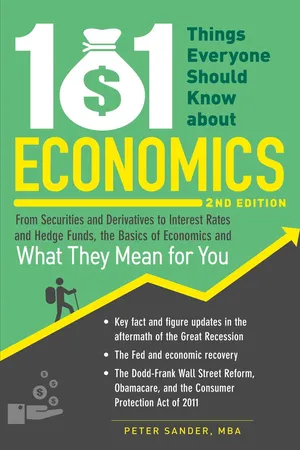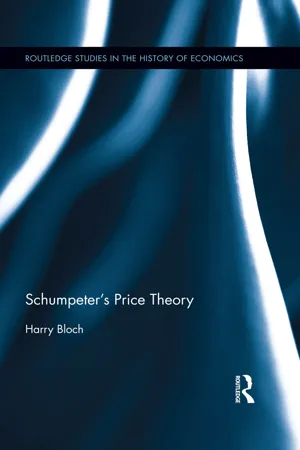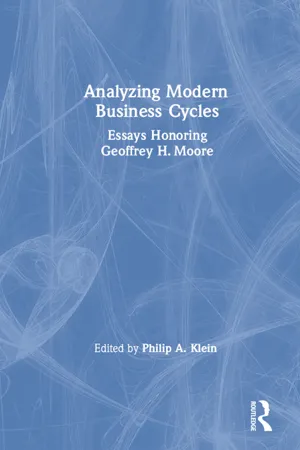Economics
Economic Cycle
The economic cycle refers to the natural fluctuation of economic activity between periods of expansion and contraction. It is characterized by alternating phases of growth, peak, recession, and trough. These cycles are influenced by various factors such as consumer spending, business investment, and government policies, and they have a significant impact on employment, inflation, and overall economic health.
Written by Perlego with AI-assistance
Related key terms
7 Key excerpts on "Economic Cycle"
- eBook - ePub
Economics for Investment Decision Makers
Micro, Macro, and International Economics
- Christopher D. Piros, Jerald E. Pinto(Authors)
- 2013(Publication Date)
- Wiley(Publisher)
Whereas the chapter on national income accounting and growth focused on long-term economic growth and the factors that help foster it, this chapter addresses short-term movements in economic activity. Some of the factors causing such short-term movements are the same as those causing economic growth, such as changes in population, technology, and capital. However, other factors, such as money and inflation, are more specific to short-term fluctuations.This chapter is organized as follows. Section 2 describes the business cycle and its phases, explaining the behaviors of businesses and households that typically characterize phases and transitions between phases. Section 3 provides an introduction to business cycle theory, in particular how different economic schools of thought interpret the business cycle and their recommendations with respect to it. Section 4 introduces basic concepts concerning unemployment and inflation, two important economic policy concerns that are sensitive to the business cycle. Section 5 discusses variables that fluctuate in predictable time relationships with the economy, focusing on variables whose movements have value in predicting the future course of the economy. A summary and practice problems conclude the chapter.2. OVERVIEW OF THE BUSINESS CYCLE
Burns and Mitchell (1946) define the business cycle as follows:Business cycles are a type of fluctuation found in the aggregate economic activity of nations that organize their work mainly in business enterprises: a cycle consists of expansions occurring at about the same time in many economic activities, followed by similarly general recessions, contractions, and revivals which merge into the expansion phase of the next cycle; this sequence of events is recurrent but not periodic; in duration, business cycles vary from more than one year to 10 or 12 years.This long definition is rich with important insights. First, business cycles are typical of economies that rely mainly on business enterprises—therefore, not agrarian societies or centrally planned economies. Second, a cycle has an expected sequence of phases representing alternation between expansion and contraction. Third, such phases occur at about the same time throughout the economy—that is, not just in agriculture or not just in tourism but in almost all sectors. Fourth, cycles are recurrent (i.e., they happen again and again over time) but not periodic (i.e., they do not all have the exact same intensity and duration). Finally, cycles typically last between one and 12 years. - eBook - ePub
101 Things Everyone Should Know About Economics
From Securities and Derivatives to Interest Rates and Hedge Funds, the Basics of Economics and What They Mean for You
- Peter Sander(Author)
- 2013(Publication Date)
- Adams Media(Publisher)
CHAPTER 2 Economy and Economic CyclesWe start with the economy. Not a big surprise in a book titled 101 Things Everyone Should Know about Economics. By way of definition, the economy is a system to allocate scarce resources to provide the things we need. That system includes the production, distribution, consumption, and exchange of goods and services. It is about what we do as a society to support ourselves, and about how we exchange what we do to take advantage of our skills, land, labor, and capital.Of course, that definition is a bit oversimplified. The economy is really a fabulously complicated mechanism that hums along at high speed—the speed of light with today’s technology—to facilitate production and consumption. The economy itself is fairly abstract, but touches us as individuals with things like income, consumption, savings, and investments, or more concretely, with money, food, cars, fuel, and savings for college.One could only wish ours was a “steady state” economy—that it would always provide exactly what we need when we needed it. Unfortunately, it isn’t so simple. The economy is directly influenced by a huge, disconnected aggregation of individual decisions. There is no “central” planning for the economy (yes, it’s been tried, but doesn’t work for a variety of reasons), although governments, central banks, and other economic authorities can influence its direction. Because the economy functions on millions of small decisions, the economy is subject to error—overproduction and overconsumption, for example. Take these errors, add in a few unforeseen events, and the result is that economies go through cycles of strength and weakness.The first fifteen entries describe the economy, Economic Cycles, economic results, and some of the measures economists use to measure economic activity.1. INCOME
Income is the money we receive in order to buy what we need when we need it. Economists look at income in several different ways—including where it comes from, how much is earned, and how much of what is earned can really be spent. Income includes the following money flows: wages to labor, profit to businesses and enterprise, interest to capital, and rent to land. - eBook - ePub
Mastering The Market Cycle
Getting the Odds on Your Side
- Howard Marks(Author)
- 2018(Publication Date)
- Mariner Books(Publisher)
IV
The Economic Cycle
The output of an economy is the product of hours worked and output per hour; thus the long-term growth of an economy is determined primarily by fundamental factors like birth rate and the rate of gain in productivity (but also by other changes in society and environment). These factors usually change relatively little from year to year, and only gradually from decade to decade. Thus the average rate of growth is rather steady over long periods of time.Given the relative stability of underlying secular growth, one might be tempted to expect that the performance of economies would be consistent from year to year. However, a number of factors are subject to variability, causing economic growth—even as it follows the underlying trendline on average—to also exhibit annual variability.The Economic Cycle (also known—mostly in the past—as “the business cycle”) provides much of the foundation for cyclical events in the business world and the markets. The more the economy rises, the more likely it is that companies will expand their profits and stock markets will rise. I’ll touch briefly here on the factors that influence Economic Cycles. But before I do so, I want to make the confession I volunteer whenever I discuss economics (or is it a proud proclamation?): I’m no economist.I took courses in economics as both an undergraduate and a graduate student. I think about economics. I deal with economics as a professional investor. And I consider myself to be largely an “economic man” who makes most decisions for logical reasons based on the relationship between cost and value, risk and potential return. But my thinking about economics is based largely on common sense and experience, and I’m sure I’ll write things here with which many economists will disagree. (Of course, they also disagree with each other. The workings of economics are quite unclear and imprecise, and thus it’s for good reason that it’s called “the dismal science.”) - Li Jianwei(Author)
- 2017(Publication Date)
- Routledge(Publisher)
1Traditional Economic Cycle theories and their limitationsThe study of Economic Cycle originated in the nineteenth century. Economists found regular cyclical fluctuations in the process of economic development, among which the fluctuation of the absolute value of British economic aggregates is the most remarkable. In 1921, Hayek defined the Economic Cycle as the circular deviation from economic equilibrium (Hayek, 1929). Since then economists have been using this definition as the starting point of the study of the Economic Cycle. Later, the integration of Economic Cycle theory and economic growth theory led to the development of growth cycle theory, which is divided into two major groups – Keynesian and neoclassical theories. The neoclassical school believes the origin of the Economic Cycle is exogenous because a temporary deviation of economic activities from the steady-state invalidates the effectiveness of government interventions. On the other hand, the Keynesian school argues that the economic growth cycle is endogenous, and government intervention can be effective in stimulating economic growth.The classical Economic Cycle theory
Following the British economic crisis of 1825, the first generation of Economic Cycle theories, known as the “classical Economic Cycle theories,” emerged. The classical Economic Cycle theories mainly focused on the study of the circular fluctuations of economic aggregates, many of which regarded the Economic Cycle as fluctuations caused by exogenous factors. This approach lacks a systematic and rigorous theoretical basis.Agricultural Economic Cycle and other exogenous Economic Cycle theories
The early studies of the Economic Cycle in the nineteenth century treated it as exogenous. They believed that the Economic Cycle is rooted in the change of factors outside the economy and not affected by economic factors. One of the most influential theories was the agricultural Economic Cycle theory.- eBook - ePub
- Harry Bloch(Author)
- 2017(Publication Date)
- Routledge(Publisher)
Business cycle theory and statistical methodsMainstream economics generally treats business cycles as arising from external shocks to the economy. These shocks disturb equilibrium, but only temporarily, as markets adjust to the shocks through a self-equilibrating process. For Schum-peter, business cycles are not aberrations, but rather an inherent part of the process of economic evolution associated with the introduction and absorption of innovations. Innovations lead to booms as entrepreneurs compete for means of production, such that, ‘The recurring periods of prosperity of the cyclical movement are the form progress takes in capitalistic society ’ (Schumpeter, 1927, p. 30, italics in the original). Recessions, in turn, are part of the process of adjustment to structural change required by the innovations, as old ways of doing things are replaced by the new.Schumpeter’s theory of the business cycle is an essential component of his theory of economic development starting from the first edition of Theorie der wirtschaftlichen Entwicklung (Schumpeter, 1926 [1912]), the precursor to the edition used for the English translation in the Theory of Economic Development (TED ) (Schumpeter, 1961 [1934]). During the period from the mid-1920s to the mid-1930s, Schumpeter references this theory in a number of journal articles, both contrasting it to the contemporaneous theories of others (as in Schumpeter, 1927, 1930) and using it as the basis for explaining the unevenness of growth under capitalism (as in Schumpeter, 1928, 1935). In the process, he puts forward a number of arguments about the necessity of integrating theory, statistics and historical analysis to achieve a full understanding of business cycles.The culmination of Schumpeter’s research on business cycles is the two-volume Business Cycles (BC) , published in 1939. While the discussion of business cycles appears in the last chapter of TED , in BC the cyclical aspect of development takes centre stage. There is an extended discussion of each of the four cycle phases, prosperity, recession, depression and recovery, along with a discussion of a multiplicity of cycles of different lengths overlapping each other. BC also contains a discussion of the application of statistical method to the interpretation of cycles and trend in time-series data. Finally, the bulk of BC - eBook - ePub
Analysing Modern Business Cycles: Essays Honoring Geoffrey H.Moore
Essays Honoring Geoffrey H.Moore
- Philip A. Klein(Author)
- 2019(Publication Date)
- Routledge(Publisher)
Classical cycles historically have been the main concern of business cycle studies at the National Bureau of Economic Research (NBER) in New York. The NBER studies began with the work of Mitchell (1927; see Moore and Zarnowitz 1986). The classical cycle fits the business cycle theories of Kalecki (1939) and Schumpeter (1939). It also fits the hints Keynes (1936) offered about the nature of business cycles; and it is the cycle that is clearly at the heart of the post-Keynesian models of, for instance, Kaldor (1940) and Hicks (1950). Table 3.1 shows that there was no classical contraction in the United States between February 1961 and December 1969, a period of 106 months; Table 3.2 shows a classical upswing continuing in Australia from September 1961 to July 1974, a period of 154 months. The experience of the 1960s, especially in the United States with no classical downturn between 1961 to 1969, contributed to a revival of interest in growth cycles. 4 Growth cycles are defined as fluctuations in the rate of growth of aggregate economic activity, with periods when the growth rate is above the long-term trend rate alternating with periods when it is below this long-term value, but not necessarily negative. This enables account to be taken of the important fact that a slowdown may occur when the growth rate, though continuing positive, is slower than the long-term trend rate of growth. Hence excess capacity, notably unemployment, rises. On the other hand, during the expansion phase of the growth cycle, when excess capacity is being absorbed, the actual rate of growth is above the long-term trend rate of growth. Table 3.1 Phases of Business Cycles, U.S., 1948–87 Sources: a CIBCR 1988a. b U.S. Department of Commerce 1988, p - Stephan Leimberg, Robert J. Doyle, Michael S. Jackson, Martin J Satinsky(Authors)
- 2019(Publication Date)
- The National Underwriter Company(Publisher)
If consumer demand would grow at a relatively constant sustainable rate, there would be far fewer fluctuations in economic activity and little or no business cycle. So why does consumer demand fluctuate?Several statistical series are especially indicative of consumer demand, including the CPI, auto sales, consumer credit, and housing starts.As noted above, each expansion sows the seeds of the following recession because every expansion is fueled by credit. Consumers and businesses borrow to buy new homes, cars, factories, and machinery. The more they borrow and spend, the faster demand grows, pushing production into higher gear in order to keep pace with demand. But sooner or later, the upward spiral of borrowing and spending comes to an end. The strain on productive capacity forces costs higher, pushing up prices. Inflation depresses consumer sentiment and consumers respond by curtailing their expenditures. Consumers also find that their incomes cannot support the burden of additional debt repayment. Businesses, having accomplished their targeted growth in plant and equipment, cut back or cease their expenditures in this area. Once business and consumer borrowing and spending start to decline, the slump begins and production and income falls. Subsequently, inflation subsides with the drop in demand. Debt is repaid. As the demand for borrowing declines, the cost of borrowing (interest rates) also declines. Businesses that have cut back on production eventually begin to deplete their inventories. With lower borrowing costs and generally lower relative materials prices and wages, producers ultimately must increase production to meet demand. Jobs increase, layoffs are called back to work, consumer sentiment rises, and with it, consumer spending. The cycle is ready to repeat itself.1. Consumer Price Index (CPI). The fluctuations in the CPI chart the course of inflation. Lower inflation leads to improved consumer sentiment and demand, which drives economic expansion forward.The CPI measures relative price changes over time. The CPI is calculated by compiling a list of goods and services purchased by the typical consumer, including such items as food, clothing, shelter, public utilities, and medical care, which make up a market basket. The price of each item is recorded and assigned a weight according to its relative importance in the basket. Changes in the prices of each item are noted and the percentage change in the total price is reflected in the change of the index number.
Learn about this page
Index pages curate the most relevant extracts from our library of academic textbooks. They’ve been created using an in-house natural language model (NLM), each adding context and meaning to key research topics.






